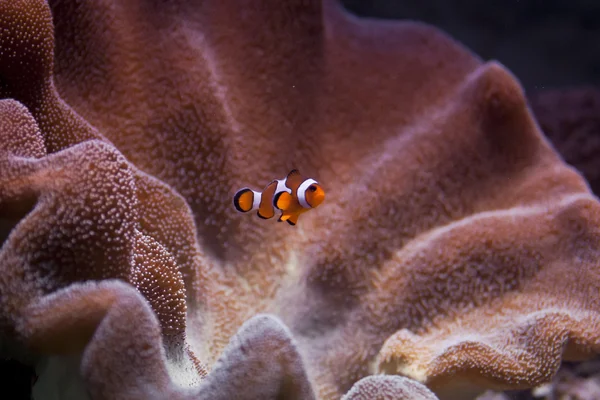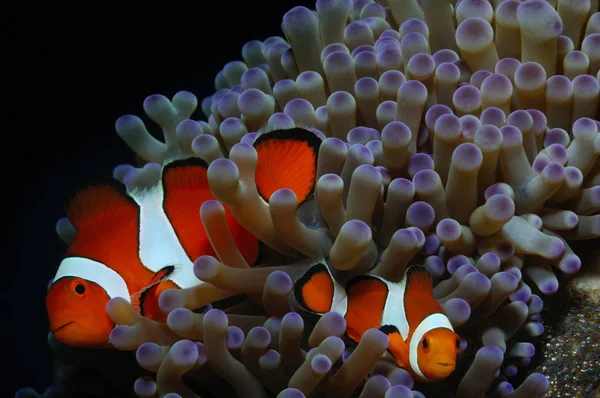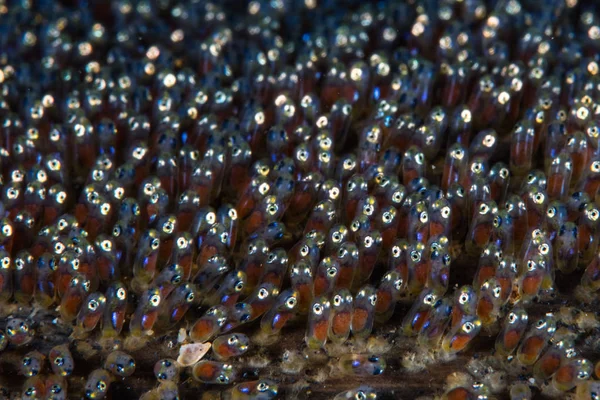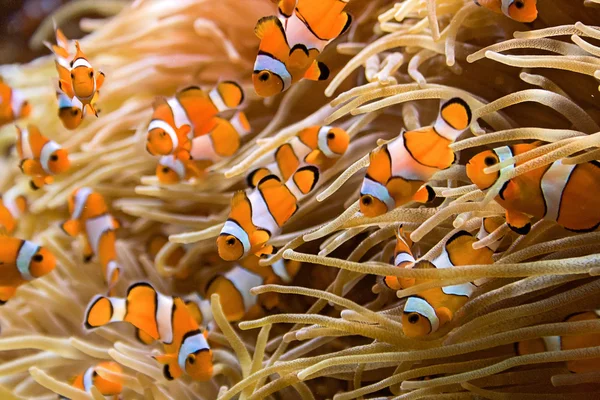Clownfish breeding is a hot topic in today’s aquarium hobby. Since so many fish are wild-caught for the saltwater trade, what is the holdup on bringing more captive-raised stock? Is it harder to breed marine fish than freshwater fish?
As it turns out, clownfish breed very easily and are a lot of fun, to boot, but how many eggs do clownfish lay? How can we get started with clownfish breeding? What do I do if my clownfish laid eggs?
Why Are Captive Bred Clownfish So Valuable?
Breeding fish for the saltwater aquarium hobby is more popular than ever before. But there are still fewer breeding tank setups compared to freshwater hatcheries. In fact, over 90% of the reef fish found in aquarium stores come from the ocean.

Saltwater ecosystems are under constant pressure from not only the pet industry. But also climate change, local fishing, pollution, and so on. So it is very important to help take the pressure off of wild stock by captive breeding clownfish and other reef fish at scale.
Are Clownfish Easy To Breed?
There are many reef aquarium fish that are in high demand. Many, if not most, are very difficult to set up a breeding tank for. Many oceanic fish have specialized needs. They may be open water spawners or have complex social dynamics. Others have pelagic babies – in the larval stage, they float freely along with the plankton soup of the open seas. So even if the aquarium fish lay eggs, they will just get sucked up into a filter or protein skimmer system.
Clownfish are much easier than many ocean fish to breed. For one, they breed by laying eggs on a hard surface, such as a handy piece of live rock that has been nibbled clean of algae and other detritus. They don’t move the eggs around and will guard them against predators. And once the eggs hatch, the fry are fairly easy to care for!
How Can I Encourage My Clownfish To Lay Eggs?
Clownfish lay eggs readily enough. But what is involved in the process of encouraging clownfish breed behavior?
Clownfish Pair Formation
Picking a pair of clownfish is not quite as simple as it is for guppies and other aquarium store fish. Like many ocean fish, clownfish don’t have fixed genders at birth. They are known as “protandrous sequential hermaphrodites.” It is a very jargon-filled term that basically means they are male at birth and then change their sex as their environment and social hierarchy dictate.
Fortunately, this also makes things a little easier for you. In a tankful of clownfish at a pet store, the vast majority of the fish are going to be male if they were captive-bred. If you are looking at wild-caught clownfish, it becomes a little more difficult. But the largest fish in the tank will most likely be female clownfish.

In clownfish, the usual sex roles are reversed; male fish are smaller, and female clownfish are the more aggressive and dominant fish. And these traits are quite flexible. If you buy a pair or several males and take them home, they will have fights to establish who is dominant. Over the course of a few weeks, the dominant fish will then transition into a new clownfish female.
This size difference is called sexual dimorphism. In clownfish, it ranges from the female being just a little bigger to more extreme cases. The Maroon Clownfish female (Premnas biaculeatus) is often several times larger than her male partner!
How Many Eggs Do Clownfish Lay?

When laying eggs, the exact number depends on the species and size of your clownfish.
Smaller species of clownfish have fewer eggs laid. 100 to 400 is common for small species like Percula Clownfish (Amphiprion percula) and Pink Skunk Clownfish (Amphiprion perideraion).
Larger species of clownfish like the Maroon Clownfish will lay up to a thousand eggs at a time.
A species’ relative age also matters when it comes to how many eggs you find. More mature clownfish lay more eggs than a new pair spawning for the first time.
Do I Need A Sea Anemone?

Aquarium enthusiasts often find their fish laying eggs next to the host anemone during clownfish breeding. Sea anemones offer clownfish, which are poor swimmers, a lot of protection thanks to their stinging tentacles. So it makes sense that clownfish eggs would be near their sea anemone home. But do you need a sea anemone for clownfish breeding?
The answer is no. In fact, you don’t need a sea anemone to keep clownfish at all. Most species will do just fine in a community tank with no anemone. But having a sea anemone allows you to witness the behaviors that have helped make clownfish so popular around the world.
The way they gently clean their host anemone, the way they protect it from other fish. Just be aware that sea anemones are more difficult to keep than clownfish. Anemones are highly sensitive to ammonia and other nitrogenous waste products. They also need bright, full-spectrum lighting – but not too much light, or they can burn. As well as low concentrations of organic pollutants to do well. Sea anemone care is not for beginners!
How Long Does It Take Clownfish Eggs To Hatch?

An adult pair of clownfish may begin regularly spawning once they take a liking to your water quality and are given enough food. You might end up with a steady supply of baby clownfish to take care of. So how long does it take for clownfish eggs to hatch?
Once your clownfish have laid eggs, it takes between 10 and 14 days for the fry to develop and hatch. After the first few days, you can sometimes see the baby clownfish inside developing. Their large eyes can sometimes be seen right through the thin shells of their eggs.
As the clownfish larvae develop, the adults will eat any unfertilized eggs or eggs infected by harmful bacteria or fungi. This helps clownfish eggs survive free of disease, which can spread from the bad eggs to the good ones.
Raising Baby Clownfish Fry
After your 10 to 14-day waiting period, the larvae hatch! However, you may not realize it right away because the newly hatched larvae are not free-swimming fish. The baby fish will sit at the bottom for the first 24 to 72 hours (depending on the species). They get all of their nutrients during this period from their yolk sac, a bulbous orange attachment on their bellies.
Once the yolk sac is used up, the baby clownfish fry will begin to lift off a little from the live rock they call home. But they won’t go far from their parents for the first few weeks of their lives.
Feeding Baby Clownfish
If you see the baby fish fry free swimming, then you know it is time to start offering them food! During the first week, they are so small that they will need to be fed live rotifers, liquid algae, and other planktonic food formulas. The fry need live food at first; the movement of these tiny prey items stimulates them to eat greedily.
After the first or second week of eating and free swimming, you can try offering them something a little larger: live brine shrimp nauplii. Most specialty aquarium stores have a constant supply of baby brine shrimp. But if not, you can hatch your own in just a couple of days if you have the eggs on hand.
Baby brine shrimp can form the core diet of clownfish fry but should be supplemented with crushed flakes and other prepared food. By offering a mixture of living and processed food, you can prepare them to eat whatever is offered in their future home.
Raising Clownfish Hatchlings

Encouraging your pets to begin laying eggs was the hard part. But raising clownfish fry is much easier. If you didn’t move your adult fish to a breeding tank, it is a good idea to transfer the clownfish hatchlings over at this point.
In a hatch tank for raising clownfish, the fry won’t have to compete in your reef tank with the other inhabitants for food. Most aquarists keep a hatch tank bare, so it is easy to clean the bottom when you perform frequent 20-50% water changes with freshly made saltwater.
All that is needed is an air stone for adequate oxygenation and a bit of current. But you can add a little decoration to your hatch tank as well if you want, such as a coral branch or chunk of live rock.
Once they grow large enough in their separate aquarium, you can then move these captive-bred clownfish to the main display tank. Or feel free to take them to local fish stores and aquarium meetup groups. After all, captive-bred clownfish fry are always in high demand, especially if they are one of the more exotic species!
Wrapping Up
Clownfish breeding is a little involved. But when it comes to breeding reef fish, clownfish are one of the easier species to spawn and raise successfully. The adults tend to be excellent parents and the fry vigorous eaters.
Clownfish breeding doesn’t involve a free-floating pelagic stage, either. Just keep the fry well-fed and watch them grow up into beautiful new specimens!
Related Reading:
- Do Clownfish Eat Their Own Eggs?
- Is Bubble Tip Anemone Difficult to Care For?
- How Can You Cure Live Rock?
- How Many Live Rocks Per Gallon?
- What Are Safe Friendly Fish for Saltwater Aquariums?
- How Long Can Clownfish Live?
- Can Clownfish Bite You?

